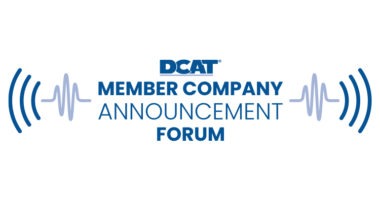What Apt to Be: Mobile Healthcare’s Impact on Drug Development
A recent study from the IMS Institute for Healthcare Informatics estimates there are now more than 165,000 mobile health applications available to consumers as developers incorporate data collection features linked to sensors and wearables. Although most apps are focused on overall wellness, there is growing interest in app use in areas such as chronic disease management. So what is the impact on drug development? DCAT Value Chain Insights (VCI) examines the implications.
The IMS Institute study found that one in ten apps has the capability to connect to a device or sensor, providing biofeedback and physiological function data from the patient and extending the accuracy and convenience of data collection. Nearly a quarter of consumer apps are focused on disease and treatment management while two-thirds target fitness and wellness. But with all that capability, 40% of apps have fewer than 5,000 downloads. Is it still too early to assess the impact or will mobile healthcare really be a game-changer on pharmaceutical development and commercialization?
The state of mobile healthcare
“While much progress has been made over the past two years, mHealth apps are still far from being a fully integrated component of healthcare delivery,” said Murray Aitken, executive director of the IMS Institute for Healthcare Informatics, in commenting on the study. “Healthcare providers are actively addressing the remaining barriers. These include developing and adopting trusted platforms for ongoing apps curation and evaluation, creating practical reimbursement models, and ensuring true interoperability within and across healthcare systems.” The IMS study, Patient Adoption of mHealth: Use, Evidence and Remaining Barriers to Mainstream Acceptance, extends the IMS Institute’s examination of consumer-focused mobile apps in the health system conducted in 2013. Researchers drew on IMS Health’s proprietary AppScript Score database and analysis of 26,864 apps available in the U.S. Apple iTunes and Android app stores—a representative sample of the most widely used mHealth apps by consumers. As part of the study, the IMS Institute also conducted structured interviews with health- and technology-focused thought leaders and executives on the role and status of healthcare apps.
The report highlights several key findings as outlined below.
App connectivity becomes a major focus for developers. In addition to improved user data collection capability, during the past two years the percentage of mHealth apps with the capability to connect to social networks increased from 26% to 34%, underscoring the importance of social networking in consumer engagement. Less progress has been made in enabling apps to connect and communicate with provider healthcare systems, a fundamental requirement for mHealth to realize its full value in healthcare management, according to the IMS analysis.
Overwhelming choice without guidance limits usefulness of healthcare apps.The total number of available mHealth apps is growing rapidly, including a 106% increase in the number of health-related Apple iOS apps since 2013. This increase has created a large number of choices for consumers, leading some to simply select the most popular app and others to try multiple apps in an effort to determine what is best for them. The IMS study found that just 12% of mHealth apps account for more than 90% of all consumer downloads, with nearly half of all downloads generated by just 36 apps. Physicians also struggle with the number of apps available and the limited mechanisms for assessing accuracy, efficacy and appropriateness for their patients. Platforms for rating, evaluating and, in some cases, certifying apps are becoming available to providers—enabling them to more confidently prescribe apps as part of disease prevention and treatment protocols. Moreover, 30-day retention rates for mHealth apps prescribed by a healthcare professional are 10% higher than those self-selected by patients. For prescribed fitness apps, the retention rate is 30% higher.
A growing movement is underway to build evidence supporting the value of mHealth apps. The majority of research studies to date focus on app usage rather than their effectiveness in improving patient outcomes or lowering healthcare costs, according to the IMS analysis. The study points out, however, that momentum is building for observational studies and randomized clinical trials that will yield evidence to support the value of apps, specifically in the areas of Type II diabetes, cardiovascular disease, obesity and mental health. The number of clinical trials using mobile apps has more than doubled in the past two years, rising from 135 to 300. The majority of trials underway are interventional, points out the study, which it says underscores the importance of providing rigorous study results to physicians in need of evidence that supports integration of apps in their treatment protocols. Demand has increased for larger clinical trials in an effort to better examine sub-populations of app users. Of the large mHealth app clinical trials that recruit patients, 53% are directed at the senior population, a key demographic that requires healthcare management and is targeted for increased app utilization, says the study.
Adoption barriers
In the IMS analysis, providers agree that the value mHealth apps can deliver is high, but barriers to full adoption remain. Among healthcare providers interviewed by the IMS Institute, most are confident that mHealth can improve overall outcomes, reduce the cost of healthcare, and encourage patients to take a more active role in improving their health. Providers emphasized that mHealth data integrated with electronic healthcare records is critical to better clinical decision-making and patient communication. Key barriers to adoption, however include: limited connectivity and integration into workflow systems; a slow paradigm shift in reimbursement processes and delivery of care; data confidentiality, privacy, security and regulatory uncertainties; lack of scientific evidence to measure the efficacy of apps; and the inability to reach the most vulnerable cohorts of patients, mainly the elderly or non-English speaking.
Impact on drug development
The impact on mHealth is likely to be gradual with its influence most likely to be first evident in use of such application in clinical trials and eventually the use of devices and sensors for certain treatments and must also be considered in line with requirements from the US Food and Drug Administration (FDA). FDA clearance is required mHealth apps that function as medical devices need to have FDA clearance. The FDA has published draft guidelines around the responsible development of devices and their supporting apps that encompass considerations for increased accuracy, integration, privacy, and related quality standards. Another factor influencing mHealth’s influence on drug development will be the improved functionality of apps. According to the IMS study, more than half of mHealth apps studies in 2014 have single functionality, with the most common capability being the ability to provide information, representing approximately two-thirds of all consumer mHealth apps. Although single functionality is important for providing consumers with information or instructing consumers to test blood glucose, for example, are important, the ability to communicate through connectiveity and integration into provider healthcare systems is crucial for further adoption and potentially for a greater role in drug development.
As of now, the vast majority of devices used in the recording or assessing of health data are fitness trackers, according to the the IMS study, followed by heart rate monitors and smart watches, all used in wellness monitoring. The reminder of the top ten devices types target chronic condition, such as heart and blood pressure monitoring, as well as diabetes and stress. Of the 282 devices assessed by the study, only 15% have received clearance from the US Food and Drug Administration. Only 5% of fitness trackers have FDA clearance compared to 75% of ECG monitors and 100% of blood glucometers, which is in line with FDA’s current criteria for mHealth apps.
Some recent examples are advancing mHealth into the pharmaceutical industry, include partnerships between IBM Watson Health, a cognitive computing and cloud platform with Teva Pharmaceutical Industries and Johnson & Johnson (on the medical device side). In August 2015, Sanofi and the life sciences team at Google formed a collaboration for developing better ways to collect, analyze, and understand multiple sources of information impacting Type 1 and Type 2 diabetes. The collaboration will pair Sanofi’s expertise in diabetes treatments and devices with Google’s expertise in analytics, miniaturized electronics, and low-power chip design. The companies will explore how to improve diabetes care by developing new tools that bring together many of the previously siloed pieces of diabetes management and enable new kinds of interventions. This includes health indicators, such as blood glucose and hemoglobin A1c levels, patient-reported information, medication regimens, and sensor devices.
In January 2015, Biogen and Google[x] Life Sciences began a partnership to explore drivers of multiple sclerosis disease progression through investigational technologies and methods, such as novel sensor platforms, advanced laboratory science, and bio-analytical tools. Google[x], is a part of Google that is devoted to finding new solutions to large global problems, which includes a life sciences focus. In 2014, Alcon, the eye-care division of Novartis, partnered with Google to in-license Google’s “smart lens” technology for ocular medical uses.The agreement with Google[x] provides Alcon with the opportunity to develop and commercialize Google’s “smart lens” technology with respect to eye care and further enhance Alcon’s pipeline and position in contact lenses and intraocular lenses.The smart lens technology involves non-invasive sensors, microchips, and other miniaturized electronics that are embedded within contact lenses. Novartis’ interest in this technology is currently focused in two areas. The first area is to help diabetic patients manage their disease by providing a continuous, minimally invasive measurement of the body’s glucose levels via a “smart contact lens,” which is designed to measure tear fluid in the eye and connects wirelessly with a mobile device. The second application is for people living with presbyopia who can no longer read without glasses, and the “smart lens” has the potential to provide accommodative vision correction to help restore the eye’s natural autofocus on near objects in the form of an accommodative contact lens or intraocular lens as part of the refractive cataract treatment.
Earlier this month, Otsuka Pharmaceutical Co., Ltd. and Proteus Digital Health reported that the FDA accepted the new drug application filing for the combination product of the Abilify (aripiprazole), a drug to treat schizophrenia, bipolar disorder, and depression, embedded with a Proteus ingestible sensor in a single tablet. According to Proteus Digital Health, this is the first time an FDA-approved medication (Abilify) has been combined and submitted for approval with a sensor within the medication tablet (the Proteus ingestible sensor) to measure actual medication-taking patterns and physiologic response. This objective information is communicated to the patient, and with the consent of the patient, to the patient’s physician and/or caregiver. Digital medicines may enable improved patient medication adherence and better informed physician decision-making to tailor treatment to the patient’s needs. The Abilify tablet contains an ingestible sensor that communicates with a wearable sensor patch and a medical software application for measuring adherence in the treatment of adults with schizophrenia, acute treatment of manic and mixed episodes associated with bipolar I disorder, and as adjunctive therapy for the treatment of major depressive disorder in adults.
If approved by the FDA, healthcare professionals will have the ability to prescribe Abilify tablets with the Proteus ingestible sensor embedded in the tablet. This drug-device product can provide the patient with a treatment option to help manage symptoms while allowing the caregiver and healthcare professional to measure medication adherence and other patient metrics. This system is filed as an NDA, where the FDA Center for Devices and Radiological Health (CDRH)-cleared ingestible sensor from Proteus will be embedded at the point of manufacture with the FDA Center for Drug Evaluation and Research (CDER)-approved Abilify as a combination drug-device, communicating with the Proteus patch and associated medical software.




